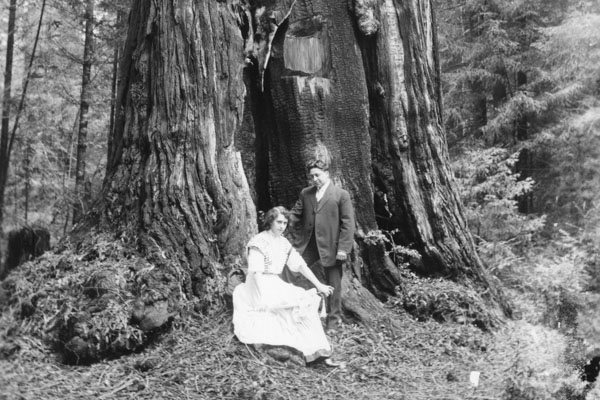You are here
Frequent Topics
Aerial Photos
Aerial Photos
Aerial Photography & Imagery - Northwestern California
A list of guides, collections and maps
Western Air Photograph Collection
Barnum Competition
Barnum Competition
The Charles R. Barnum History Awards were established by a grant from Mr. Barnum in the late fall of 1952. Barnum was a realtor and insurance broker, and a member of the Humboldt State College Advisory Board from March 1946 until his death in February 1953. The purpose of the trust he established is "to aid, assist and encourage worthy students of Humboldt State College in furthering their interest in original historical research of Humboldt County."
More on the Charles R. Barnum History Awards
Catalogs, Humboldt State, Cal Poly Humboldt
Catalogs, Humboldt State, Cal Poly Humboldt
A complete set, 1915 to present, is in Special Collections (LD 729 C975 A3). Copies may be checked out at the Circulation Desk.
Citing Items from Special Collections
Citing Items from Special Collections
This guide serves as a resource for citing items you find in Special Collections. You may be required to cite primary sources such as photographs, collections, pamphlets, and other materials. Many citation styles exist outside of the styles covered in this guide (APA, Chicago, MLA). Consult the style guide you are using to learn how to cite your chosen source appropriately.
City Directories
City Directories
- The single city directory for Humboldt County has had various titles over time and has varied in its coverage (F 869 E8 A18)
- A copy of the Humboldt pages of the 1884-5 McKenney's 8-county directory (F868 H8 M385 1883a)
- Humboldt Standard Classified directory; containing the names, addresses and telephone numbers of representative manufacturing, business and professional interests and institutions of Eureka, California, and vicinity, 1923 (F868 H8 H88)
- Humboldt A to Z directory and guide book, 1940-1941 (F868 H8 E868)
- Business and professional directory, 1949 (F868 H8 E87)
- Classified directory and guide book, 1951/52, 1955/56 (F868 H8 E87)
Environmental Impact Assessment Reports
Environmental Impact Assessment Reports
Environmental impact assessment reports evaluate the environmental implications of actions by federal, state, and other governmental agencies.
Eureka Chinatown
Eureka Chinatown
In the late 1800s, on the block of land bounded by E, F, 4th, and 5th streets in Eureka, over 300 Chinese people once lived in a bustling Chinatown. But the Chinese Exclusion Act of 1882, the first U.S. law to ban immigration by race, gave way to a brutal wave of ethnic cleansing across the Pacific Northwest.
The Chinese in Humboldt Research Aid is a great place to start your research. The finding aid for the pamphlet file is downloadable in PDF form.
Click here to search the One Drive for "Chinese Expulsion in Humboldt County," for books and other resources on the topic.
Finding Aids
Finding Aids
Finding aids are indexes to special collections located in libraries, historical societies, and museums. Typically a finding aid provides description and biographical information about the collection as well as an inventory of primary source materials in the collection. Finding aids for Cal Poly Humboldt collections are linked in the Special Collections List of Collections. Listed below are finding aids to collections of important sources of information about some aspect of northwestern California that are NOT at the Cal Poly Humboldt Library. These finding aids are all on the Online Archive of California (OAC).
More info on Finding Aids from Cal Poly Humboldt and other sources
Humboldt Honey
Indians, Northwestern California
Indians, Northwestern California
Start with these three sources in the Main Collection on the second floor: Handbook of North American Indians Volume 8, California; Native America in the Twentieth Century; and Ethnography and Folklore of the Indians of Northwestern California. Call numbers for these and other reference books can be found in the guide Sources on North American Indians. See also the websites listed in Native American Studies Research Guide.
Local History
Local History
The Lumberjack
The Lumberjack
- Cal Poly Humboldt's student newspaper has published since 1930. The issues have been digitized and are keyword searchable here.
- Physical copies of the Cal Poly Humboldt student newspaper are maintained in the Cal Poly Humboldt Library Special Collections and Archives. Additionally, copies are available on microfilm and can be accessed on the second floor of the library.
Place Names
Place Names
Begin with Turner's Place Names of Humboldt County (F 868 H8 T87 1993) in either the Main Collection or the Humboldt County Collection and then follow-up on his references.
Statistics, Demographic, Economic, etc
Statistics, Demographic, Economic, etc
The best source for current county statistics is Health Data Summaries (HA 261 H43) in the Main Collection and online; see also Population History Maps of California Places 1770-2000 (HB 3525 C2 B471 2000). In Special Collections, check the Humboldt County Economic and Demographic Almanac (HC 107 C22 H834) and the Humboldt County Economic and Demographic Profile (HC 107 C22 H8346), both annual publications. The Cal Poly Humboldt Office of Institutional Research, Analytics, and Reporting webpage provides figures for Cal Poly Humboldt and the Humboldt Economic Index is great for Humboldt County. The Humboldt County Community Development Services Department has an extensive Demographic Data page. Many print as well as web statistical sources are included in Research Guides: Northwestern California/Klamath Bioregion Demographic, Social and Economic Statistics.
Theses
Theses
This guide explains how to find and acquire 1) HSU masters theses; and 2) theses and dissertations produced at other universities that are available from other libraries or fulltext on the Internet.
Yearbooks, Humboldt State
Yearbooks, Humboldt State
College yearbooks were published for selected years as follows: 1927 Cabrillo (LD 729.6 A6 C32); 1938-1966 Sempervirens (LD 729.6 A6 S45); 1977-1978 The Lamp (LD 729.6 A6 L35); 1982-1985 Yearbook (LD 729.6 A6 H89). A complete set is in Special Collctions. Copies may be checked out at the Circulation Desk. Copies of some Humboldt yearbooks are available online and for download in Humboldt Digital Scholar.










